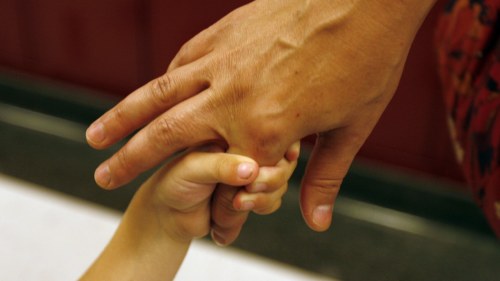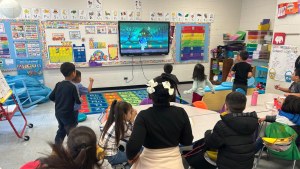The newcomers: schools are migrants' gateway to Chicago's local economy

Integrating migrant children and their parents into local schools also integrates them into the local economy.
Chicago Public Schools (CPS) doesn’t know exactly how many new migrant students they’ve enrolled this year. But 16 schools have each received more than 50 migrant students currently living in shelters, and there are at least 7,000 more students enrolled in CPS as English language learners compared to last year.
That’s according to CPS’ “Newcomer Support” update, shared with ChicagoGlobal, which details how schools are responding to the influx of about 20,000 migrants seeking asylum who arrived in Chicago this year from the southern border.
Incorporating migrant students and their families into school communities takes time and resources. But as schools and these families begin to develop trusting relationships, schools can become an entry point for the migrants into Chicago’s local economy.
Students and parents often turn to their schools’ teachers and principals to ask where they can get services, such as health care and legal aid, and essential goods, like clothing and school supplies, that help them feel more economically secure.
Subscribe to ChicagoGlobal
This story first appeared in the ChicagoGlobal newsletter, a joint project of Crain's Chicago Business and the Chicago Council on Global Affairs.
CPS has around 1,800 jobs available and faces an acute school bus driver shortage. Many schools want to hire migrant parents, but a federal backlog of work permit approvals is slowing down the process, said Dr. Karime Asaf, chief of language and cultural education at CPS.
“I think that most principals are just dying for the opportunity to insert, include, incorporate these parents more holistically into their own spaces because they’re very valuable,” she told ChicagoGlobal.
Who is a “newcomer” student and what do they need?
“Supporting the newcomers … it is a privilege, and it’s also a challenge that keeps me up at night,” Asaf said.
Keeping track of these students on paper – and their parents – is a challenge for CPS. The district knows when students are living in shelters, but during former President Trump’s administration, CPS stopped tracking students' migrant status.
Now, CPS is recording students' countries of origin and whether it's a student’s first time attending public school in the U.S. This is part of the reason CPS calls the recent migrant, refugee, and asylum-seeking students “newcomers.”

Students in a classroom for English language learners at Jordan Community Elementary School in Rogers Park.
In addition to providing more teachers for students learning English, the district’s office for Students in Temporary Living Situations is trying to provide essentials to students living in police stations and migrant shelters.
Chris Graves is the principal at Jordan Community Elementary School in Rogers Park, which is 95% students of color, many of whom are children of asylum-seekers from South America or refugees from Syria, Ukraine, and Sudan. Graves said the district’s office recently sent him a list of all his newcomer students and asked for their clothing sizes and essentials they needed.
Schools connect parents with services, and they want to offer jobs
Without support from the school, Graves said, families don’t know where to get basic services like health care. That’s why CPS recently hired a newcomer liaison to connect parents with community businesses and organizations that provide services the school can’t.
“He's creating a database of all of our community organizations. So a few examples could be legal support, right? Immigration support. It could be, you know, teeth cleanings, right? ‘Where do I go to get my children's … cavities filled?’” Graves said.
“They know the people in our building, know their child’s teacher. They know me,” he added.
In addition to supporting students, the district sees an opportunity to engage their parents to support the district, including hiring them to fill vacant positions. But there are logistical, linguistic, and cultural barriers to cross first.
Parents who have been granted refugee status arrive with paperwork that allows them to find employment. However, asylum-seekers with Temporary Protected Status, like those who arrived in Chicago from Venezuela, need to apply for work permits, which takes time and money.
Top 10 EL Home Languages (SY19-SY24)
CPS’ “Newcomer Support” update shows that most English language learners speak Spanish, but Arabic and Ukrainian have become the second- and third-most spoken languages among migrant families, respectively. In addition, Asaf says many of the newcomers’ parents speak indigenous South American languages like Quechua.
| SY19 | SY20 | SY21 | SY22 | SY23 | SY24 |
|---|---|---|---|---|---|
| Spanish 83.4% | Spanish 83.5% | Spanish 84.1% | Spanish 84.1% | Spanish 83.7% | Spanish 84.8% |
| Arabic 2.2% | Arabic 2.2% | Arabic 2.1% | Arabic 2.2% | Arabic 2.1% | Arabic 2.1% |
| Urdu 1.3% | Cantonese (Chinese) 1.3% | Cantonese (Chinese) 1.3% | Cantonese (Chinese) 1.3% | Ukrainian 1.3% | Ukrainian 1.4% |
| Cantonese (Chinese) 1.3% | Urdu 1.2% | Urdu 1.2% | Urdu 1.1% | Cantonese (Chinese) 1.2% | Cantonese (Chinese) 1.1% |
| Polish 1.1% | Polish 1.1% | Polish 1.0% | Polish 0.9% | Urdu 1.0% | Urdu 1.0% |
| Mandarin (Chinese) 0.7% | Mandarin (Chinese) 0.7% | Vietnamese 0.7% | Vietnamese 0.6% | Polish 0.8% | Russian 0.8% |
| Yoruba 0.7% | Vietnamese 0.7% | Mandarin (Chinese) 0.7% | Mandarin (Chinese) 0.6% | Russian 0.7% | Polish 0.8% |
| Vietnamese 0.6% | Yoruba 0.6% | Pilipino (Tagalog) 0.6% | Yoruba 0.5% | Mandarin (Chinese) 0.6% | Mandarin (Chinese) 0.6% |
| Pilipino (Tagalog) 0.6% | Pilipino (Tagalog) 0.6% | Yoruba 0.6% | Pilipino (Tagalog) 0.5% | Vietnamese 0.6% | Vietnamese 0.5% |
| Ukrainian 0.5% | Ukrainian 0.5% | Ukrainian 0.4% | Ukrainian 0.5% | Pilipino (Tagalog) 0.5% | Pilipino (Tagalog) 0.5% |
Source: Chicago Public Schools “Newcomer Support: Current State and Plan
Chicago provides these families with a specialized I.D. called a Civic Key that allows parents to become official volunteers in schools. However, Graves said that volunteering in schools is not a common cultural practice in some of the South American countries that families come from.
“They might come from countries where the schooling is part of the government,” Graves explained, “and I wouldn’t go and volunteer in city hall – like, that’s not a thing, right? I wouldn’t volunteer at [the Chicago Police Department] – that’s not a thing, right?”
But volunteering can be a pathway to future employment for some students’ parents, he added.
His school has hired parents who are refugees to provide student support services like recess supervision. Even if they don’t speak much English, Graves said, it’s not necessary in many of these roles. More importantly, he said he knows they are invested “because their kid is right down the hallway.”
In addition, these parents could provide translation services.
“CPS goes into other countries to import bilingual teachers, and we sponsor their visas,” Asaf said. In the future, she hopes that CPS might instead be able to hire recent arrivals with college degrees as bilingual teachers.
The “Newcomer Support” plan shows that schools that have received large numbers of newcomer students have received additional funding that could be used to hire new staff.
“Maybe we could sponsor [them] to be working in classrooms,” she added.
Graves can hire parents who are refugees because they already have work permits. But that’s not the case for many asylum-seekers: Though many are eligible to receive work permits, the backlogged approval process is going very slowly, Asaf said.
“When I got a wonderful family that shows up every day and they’ve been volunteering, I’m like ‘They deserve to get paid,’” Graves said.
“It would be a game changer if we could just hire for all these vacant positions.”
This story first appeared in the ChicagoGlobal newsletter, a joint project of Crain's Chicago Business and the Chicago Council on Global Affairs. Subscribe today.

